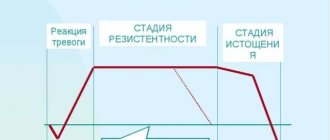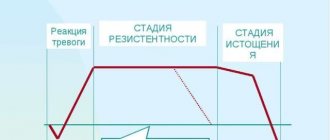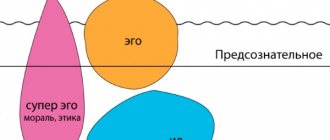Stress is good and bad: we understand the types and stages of development
In fact, stress helps our body; it is a natural mechanism that triggers the process of adaptation to any internal and external changes.
For example: You cut your finger - you experience stress, which makes your body understand that it’s time to leave the rescue team to heal the wound. or you have flown to a tropical country - stress tells the body what and how to change in order to more easily endure the heat and humidity.
However, stress can develop into a permanent state and then it becomes dangerous for your entire health and normal life.
Stress can be of two types: positive and negative.
Eustress and Distress
Eustress
The first form is eustress, which can be caused by both positive emotions (positive) and negative events (mobilizing).
In this state, a person is aware of his problems, his condition. The body mobilizes and concentrates on completing tasks. This occurs under the influence of adrenaline and other related hormones.
A person's activity increases. He successfully copes with assigned tasks at work and at home. But the resource of the human body is exhausted. Prolonged negativity leads to a destructive form.
Distress
Depletes the nervous system and destroys the body. Mental activity suffers, our performance decreases. Stress targets the immune system and attacks it. The body becomes vulnerable to various diseases.
Distress (from the English Distress) - grief, suffering, severe malaise, exhaustion.
Distress is divided into several subtypes
Physiological
The physiological type arises as a response to unfavorable internal factors and unmet physiological needs. They can be pain, hunger, thirst, abstinence. Negative environmental conditions also contribute. Cold, constant noise, and air pollution become stress for us.
Emotional
Our emotions can also cause stress. The emotional type is one of the most common types of stress. Even joyful events cause distress. It's all about prolonged emotional stress. It ultimately leads to psychological and moral exhaustion.
Short-term
The short-term type occurs as a response to a sudden strong impact. Manifests itself as fear and other reactions. It usually passes quickly and has no consequences, but can be deep and traumatic.
Chronic
The most severe and dangerous type is the chronic type. Negative factors influence us constantly. A person does not notice them, they become the “background”. However, ultimately, this “background” leads not only to nervous exhaustion, but also to illness, depression, and a general decrease in the quality of life.
Study of daily fluctuations of steroid hormones contained in saliva - cortisol and dehydroepiandrosterone - which take part in the neuroendocrine mechanisms of the development of stress, as well as reflecting the stages of its course and the adaptive capabilities of the body.
Determined parameters: - Cortisol (morning) - Cortisol (noon) - Cortisol (day) - Cortisol (noon + day)/2 - Cortisol (evening) - Total cortisol - Dehydroepiandrosterone (DHEA) (morning) - Dehydroepiandrosterone (DHEA) (noon ) - Dehydroepiandrosterone (DHEA) (day) - Dehydroepiandrosterone (DHEA) (noon + day)/2 - Dehydroepiandrosterone (DHEA) (evening) - DHEA/Cortisol ratio (marker of stress resistance).
Synonyms Russian
Cortisol (morning, afternoon, evening and night portions), dehydroepiandrosterone (DHEA), the ratio of DHEA and cortisol (a marker of stress resistance) in saliva.
English synonyms
24 hour Salivary Adrenal Stress Profile, Salivary cortisol and dehydroepiandrosterone (DHEA) measurement.
Research method
High performance liquid chromatography-mass spectrometry (HPLC-MS).
Units
ng/ml (nanograms per milliliter).
What biomaterial can be used for research?
Saliva.
How to properly prepare for research?
- The day before and during the entire period of saliva collection, avoid the consumption of caffeine, alcohol, and physical activity.
- Taking sedatives, cortisone acetate, estrogens, oral contraceptives, glucocorticoid drugs (including ointments) can cause an increase in cortisol levels. Discontinuation of medications is carried out strictly on the recommendation of the attending physician.
- Do not smoke for 1 hour before saliva collection.
- 10 minutes before collecting saliva, rinse your mouth with water.
- 30 minutes before collecting saliva, refrain from eating, brushing your teeth, using dental floss, mouth rinses and chewing gum.
General information about the study
A person in the process of his life is constantly exposed to various unfavorable factors. Moreover, in the modern world, among them, first of all, technogenic and psychosocial impacts come to the fore: physical and mental overload, sedentary lifestyle, long-term lack of rest, emotional exhaustion, monotonous work, conflicts, general dissatisfaction, etc. The effect of such factors on the human body puts it in a state of stress. Stress is a complex of physiological changes in the functioning of the nervous and endocrine systems, as well as other internal organs, that arise in response to the action of an irritant. It is a protective, adaptive reaction that allows the body, having mobilized all possible reserves, to survive an unfavorable period.
One of the physiological mechanisms for the development of a stress response is the activation of the hypothalamic-pituitary-adrenal system: the hypothalamus secretes corticoliberin, which stimulates the pituitary gland's secretion of adrenocorticotropic hormone (ACTH), and under the influence of ACTH, the production of the steroid hormone cortisol is activated in the adrenal cortex. Metabolic changes that occur in the body under the influence of cortisol are critical for successful adaptation to stress. Under conditions of stress, nervous tissue requires a large amount of energy, which is provided through the synthesis of glucose from non-carbohydrate substances. Under the influence of cortisol, some of the skeletal muscle proteins break down to their initial components - amino acids, from which glucose is then formed. This is the catabolic effect of the hormone, which, during the period of adaptation to a stressor, helps to effectively distribute the body’s energy resources. At the same time, long-term persistence of such a metabolic restructuring would have a negative effect on the body, therefore there are physiological mechanisms for inhibiting the synthesis of cortisol. They include, first of all, a decrease in the production of corticoliberin under the influence of cortisol itself (the so-called negative feedback) and the parallel production of another steroid hormone by the adrenal glands - dehydroepiandrosterone (DHEA), which has an effect opposite to cortisol. A constant level of DHEA in the blood prevents the development of psychological maladjustment and stress-induced diseases. In addition, a number of modern studies on the effects of stress on human health have shown a connection between the DHEA/cortisol ratio and the development of disorders in the cardiovascular, nervous and reproductive systems, as well as social adaptation.
A feature of most stress factors of the present time is their long-term impact. At the same time, the body’s neuroendocrine adaptation mechanisms are certainly not designed for such situations - they are necessary to gain time and either cope with unfavorable conditions or escape from the sphere of their influence. Modern people often cannot cope with a stressor (or do not take it into account) and continue to be under its influence, which leads to a loss of control over adaptation mechanisms, their exhaustion and the development of pathological conditions. The regularity of the course of stress and accompanying neuroendocrine processes is reflected in the following stages:
- The first stage – the alarm reaction – is the stage of mobilization of the body’s adaptive capabilities. This is a normal short-term response to stress. At this stage, the work of the hypothalamic-pituitary-adrenal system is activated, the level of cortisol in the blood increases, and catabolic processes begin to predominate for increased energy supply to the nervous system. The pattern of changes in the hormonal profile of saliva at this stage will be as follows: increased cortisol levels, normal DHEA levels.
- The second stage - the stage of resistance - is characterized by long-term adaptation to the ongoing effect of the stressor. Thanks to the formation of adaptive mechanisms, energy consumption at this stage becomes less, but the amount of hormones produced, including cortisol, remains increased - it corresponds to the needs of the body under stressor conditions. In this case, the common substrate necessary for the synthesis of cortisol and DHEA is used exclusively for the production of the former, as a result of which the level of DHEA decreases. This is the first sign of adrenal fatigue. Hormonal pattern in saliva: elevated cortisol and low DHEA.
- The third stage - the stage of exhaustion - occurs if the effect of the damaging factor has not ended, but the adaptive capabilities of the body have already been exhausted. Adrenal fatigue at this stage is manifested by decreased levels of both cortisol and DHEA. The salivary pattern will first change to normal cortisol levels and decreased DHEA levels, and then low concentrations of both hormones will be detected.
- Subsequently, with successful adaptation to the stressor or cessation of its effect at the beginning of adrenal recovery, the level of DHEA gradually normalizes, while the concentration of cortisol remains low.
In the blood, a certain part of cortisol and DHEA is bound to plasma proteins and does not have biological activity. For diagnostic purposes, it is preferable to determine the concentration of free hormones, that is, not associated with plasma proteins. Molecules contained in the blood can pass through the membrane that separates the bloodstream from the ducts of the salivary glands. Free fractions of steroid hormones, being lipophilic molecules with a relatively small molecular weight, can freely penetrate the membrane of the salivary glands, but, on the contrary, it is impermeable to those bound to plasma proteins. Thus, measuring the concentration of hormones in saliva provides information about the level of their biologically active – “free” fractions.
The production of cortisol by the adrenal glands follows a circadian rhythm - it is maximum in the morning and reaches minimum values at night. Variations in the intensity of cortisol secretion are quite significant, so the study requires at least 4 samples of biological material collected at different periods of the day. The use of saliva as a research material in this situation has great advantages, since its collection is a non-invasive, painless and convenient procedure.
What is the research used for?
- Study of the endocrine response to acute and chronic stress;
- in sports medicine – for diagnosing “overtraining syndrome”;
- in industrial medicine for the purpose of differentiating easily and poorly adaptable people (for example, during work accompanied by a high probability of developing stress).
When is the study scheduled?
If you have symptoms and signs of prolonged stress or adrenal dysfunction, which may include:
- neurological disorders such as chronic fatigue syndrome (especially morning fatigue), mood disorders, depression, anxiety, memory and concentration problems;
- metabolic disorders - obesity (often accumulation of fat in the waist and abdomen), thyroid dysfunction, menstrual irregularities;
- digestive disorders - constipation, diarrhea, bile reflux in the stomach and esophagus, peptic ulcer;
- skin diseases - psoriasis, eczema;
- decreased sexual desire.
What do the results mean?
Reference values
| Cortisol (morning), ng/ml | Age | Women | Men |
| 21-31 years old | 1,12 — 7,43 | 2,72 — 13,5 | |
| 31-51 years | 1,22 — 15,5 | 0,94 — 15,1 | |
| 51 years and older | 1,12 — 8,12 | 1,49 — 7,39 | |
| Cortisol (noon), ng/ml | Age | Women | Men |
| 21-31 years old | 0,8 — 5,2 | 2,0 — 7,5 | |
| 31-51 years | 0,65 — 7,0 | 0,4 — 6,4 | |
| 51 years and older | 1,2 — 5,4 | 0,95 — 6,8 | |
| Cortisol (day), ng/ml | Age | Women | Men |
| 21-31 years old | 0,5 — 4,5 | 1,5 — 5,0 | |
| 31-51 years | 0,32 — 4,5 | 0,18 — 4,3 | |
| 51 years and older | 0,6 — 3,8 | 0,51 — 4,2 | |
| Cortisol (noon + day)/2 - A, ng/ml | Age | Women | Men |
| 21-31 years old | 0,5 — 5,2 | 1,5 — 7,5 | |
| 31-51 years | 0,32 — 7,0 | 0,18 — 6,4 | |
| 51 years old and | 0,6 — 5,4 | 0,51 — 6,8 | |
| Cortisol (evening), ng/ml | Age | Women | Men |
| 21-31 years old | |||
| 31-51 years | |||
| 51 years and older | 0,22 — 2,54 | ||
| Total cortisol, ng/ml | Age | Women | Men |
| 21-31 years old | 2,5 — 20,0 | 5,0 — 22,0 | |
| 31-51 years | 3,0 — 22,5 | 2,9 — 18,4 | |
| 51 years and older | 2,0 — 16,5 | 1,8 — 18,6 |
| Dehydroepiandrosterone (DHEA) (morning), ng/ml | Women | Men |
| 0,106 — 0,3 | 0,137 — 0,336 | |
| Dehydroepiandrosterone (DHEA) (midday), ng/ml | Women | Men |
| 0,106 — 0,3 | 0,137 — 0,336 | |
| Dehydroepiandrosterone (DHEA) (day), ng/ml | Women | Men |
| 0,106 — 0,3 | 0,137 — 0,336 | |
| Dehydroepiandrosterone (DHEA) (noon+day)/2 - B, ng/ml | Women | Men |
| 0,106 — 0,3 | 0,137 — 0,336 | |
| Dehydroepiandrosterone (DHEA) (evening), ng/ml | Women | Men |
| 0,106 — 0,3 | 0,137 — 0,336 |
| DHEA/cortisol ratio | 115,0 — 1 200,0 |
Typically, an increase in cortisol levels is regarded as an indicator of the presence of stress - with acute stress, cortisol production increases. However, with prolonged exposure to an unfavorable factor, both an increase and a decrease in the activity of the hypothalamic-pituitary-adrenal system is possible, which is manifested, accordingly, by an increase or decrease in the concentration of the hormone. According to pooled data from several studies, increased cortisol production is more common in depression. And post-traumatic stress disorder, chronic tension syndrome and general psychological exhaustion are associated with a decrease in its level.
A more detailed correlation between the level of hormones determined in this study and the course of stress is given in the “General information about the study” section.
The stress resistance index - the ratio of DHEA to cortisol - is interpreted taking into account its deviations from the reference interval: below the lower limit - reduced ability to adapt, above - increased, within the interval - ability to adapt is preserved.
Causes
The main reason is the situations that provoke it, they are called stress factors. Considering that the life of a modern person is dynamic and unpredictable, there are a great many reasons. Constant troubles, misunderstandings with loved ones, pressing stress at work, breakdowns of household appliances or cars, and just everyday worries. All this provokes irritation and anxiety.
Sometimes the lack of change, routine and “Groundhog Day” can be the main reason. Each person has their own individual mental characteristics, which for one is an annoying nuisance, for another a cause of stress.
Causes
Main reasons
- conflicts with family and friends;
- unemployment and debt;
- overwork, lack of vacation;
- chronic diseases and excess weight
- dissatisfaction with oneself and one's appearance
Stress develops at three levels: biochemical, psychological and physiological.
When a person finds himself in a stressful situation, his blood glucose level rises, blood pressure rises, the heartbeat becomes more frequent, the deposition of fatty tissue in the subcutaneous tissue increases, sodium is retained, and with it water in the tissues, and potassium, which is necessary for the functioning of the heart and nerves, is eliminated faster than necessary.
What is stress
Stress is a completely normal response of the body to overwork or threat. At the same time, the body tries to resist in every possible way, as a result of which we suffer. When this protection works normally, it helps a person to be cheerful, energetic, concentrated and on a pedestal. But stress often has a detrimental effect on our mental and physical health.
Photo on Unsplash
Stress is a long-term, continuous, depressing emotional tension. When growing multitasking does not allow you to relax for a minute. When you constantly need to look for solutions, here and now. When everything seems global and urgent.
Types of people in stressful situations
Each person reacts to sources of stress individually; each phase can last longer or shorter for different people. This depends on a person’s resistance to stress, on his ability to quickly “bend under” the situation and find the right solution to solve the problem.
Experts have found that there are different reactions to stress and have identified 3 types of people:
- those who can withstand stress for a long time
, while being in excellent shape and in an adequate mental state; - those who, when a problem arises, lose their ability to work
, it is difficult for them to find a solution and adapt to new conditions; - those who can work productively and show high results only under stress
, problems “spur them on” and force them to move forward.










